Appreciating Buddhist Art: Part Two – Dhyani Buddhas
PRIMITIVE - Friday, July 10, 2015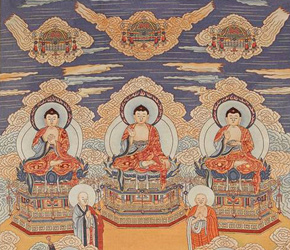 |
|
By Misaki Imagawa
Last night I dreamt the grass was soft against the soles of my bare feet. The air was warm and birds fluttered and sang from their perches in the lush trees. Fish darted beneath the surface of a pond. I walked over the grass where no path marked the ground; yet I knew where to go. I reached out and parted the branches of a bush and saw a man sitting beneath an ancient fig tree. He sat so still I wondered if he was actually a statue; but as I approached, his eyes opened and without saying a word, he welcomed me. Instinctively, I knew it was Buddha. The enormity of sitting down before him hit me in my waking state; but in my dream there was no panic to be felt, no decisions to be made - everything just flowed. I sifted through many questions and asked only one: "What qualities must we have to become like you, to become a Buddha?" The figure in my dream looked over my shoulder and pointed; and I turned to see five more figures. “Become like them,” said the Buddha, voicing words for the first time. I looked closely. Each figure looked alike at first blush, but upon closer examination was slightly different with their own appearance and personality.
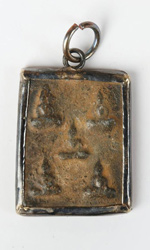 |
|
“These are the five Dhyani Buddhas,” he said. “Each personifies a skandha – the five elements that combine to create existence and make you who you are. First, there is Matter or Form; this is personified by the Buddha Vairocana. Second, there is Sensation, which is Ratnasambhava. Third, there is Perception; this is Amitabha. Fourth, there is Mental Formation; this is the Buddha Amoghasiddhi. Finally, there is Consciousness, which is Ashkobhya.” I did not think it a coincidence that the order of the skandhas reflected the development stages of a newborn baby. “Wait,” I said as my dream started to fade. “If the Five Dhyani Buddhas represent aspects of ‘us’ and they’re also qualities of a Buddha, does that mean we’re all capable of attaining Buddhahood?” He smiled and then answered, "Yes. It is in us all.”
The five Dhyani Buddhas are popular subjects of Buddhist art. Each of them represents a different skandha, or aspect of existence. This can also be interpreted as different qualities of Buddha himself. The Dhyani are sometimes referred to as primordial Buddhas, each representing an abstract aspect of enlightened consciousness. Some depictions of Dhyani Buddhas are almost impossible to distinguish from those of the historical Buddha, Gautama Siddhartha, also known as Shakyamuni. Achieving an understanding of each of the Dhyani Buddhas and being able to distinguish them from other images of Buddha will greatly enhance your understanding of Buddhism as well as your experience of viewing Buddhist art. Asian cultures tend to portray Buddhas in different styles, so looking at common elements such as mudra, color, attributes, and position in relation to other Buddhas is key to identifying which Buddha is actually being depicted, and in turn, what teaching is being conveyed.
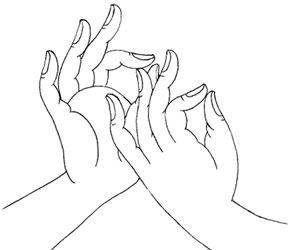 |
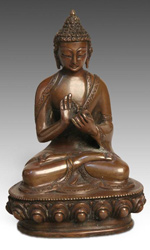 |
||
1) The first of the Dhyani Buddhas is Vairocana, who represents the Dharmakaya, or the formless body, which can be interpreted as the unmanifested universe. It is from the Dharmakaya that all things arise and return after their dissolution. Vairocana represents the first skandha – our physical form. When shown in a mandala – graphic symbols depicting the universe that often illustrate the five Dhyani Buddhas together – Vairocana is positioned in the center and is considered the main deity. In this regard, he represents transcendent wisdom. His symbol is the dharma wheel, the Wheel of the Law that represents Buddha’s teachings.
 |
|
The word mudra refers to a specific hand gesture; and which mudra is depicted provides a valuable clue in identifying any particular Buddha image. As one who turns the dharma wheel, the mudra of Vairocana is known as Dharmachakra. This is the mudra of teaching. In this mudra the thumb and index finger of both hands touch at their tips to form a circle. This circle represents the dharma wheel, or in metaphysical terms, the union of method and wisdom.
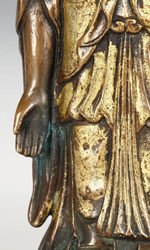 |
|
Vairocana is associated with the color white to symbolize the radiance from which all things take form. Perhaps in association to his color, he is called Dainichi in Japan, which translates as ‘the great sun.’ In fact, the name Vairocana means ‘he who is like the sun’ or ‘the radiating one.’
Tips to identifying Vairocana: the color white, the Dharmachakra mudra, his appearance at the center of a mandala, and the dharma wheel as an attribute.
2) In the southern position of a mandala is the Dhyani Buddha Ratnasambhava, representing the teaching of ‘equality and equanimity,’ or sameness. He teaches his followers to ‘share,’ not ‘give,’ ensuring that every being is equal and in harmony. In this state of enlightenment there is nobody superior or inferior to the other. Ratnasambhava embodies the second skandha, sensation, which encompasses all our feelings and senses. Recognition of this skandha is an acknowledgement of the commonality found in all sentient beings.
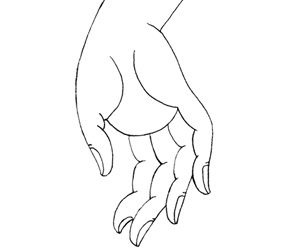 |
|
Ratnasambhava is sometimes called the ‘Origin of Jewels’ and is depicted being adorned in lavish gems, or holding a jewel. These attributes do not symbolize an attachment to worldly wealth, but rather the capacity to enrich the lives of people through sharing the Three Jewels: Buddha, Dharma and Sangha (teacher, teachings and community). Ratnasambhava displays the Varada mudra. This mudra symbolizes charity and the capacity to grant wishes and also relates to the devotion of oneself to the salvation of humanity. In this mudra, the right arm hangs naturally at the side of the body with the palm facing outward and fingers extended. This mudra is commonly shown in conjunction with other mudras in the left hand. Often, his left hand is shown supporting a begging or alms bowl, which symbolizes the opportunity for merit. Ratnasambhava’s color is yellow or gold, considered the color of the sun and earth. It is the color associated with energy, abundance, and generosity, like the sun washing the earth with abundant light.
Tips to identifying Ratnasambhava: the color yellow, the Varada Mudra, his placement in a southern (bottom) position in a mandala,the appearance of gemstones or the deity holding a jewel.
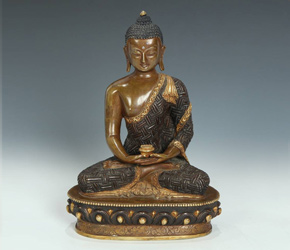 |
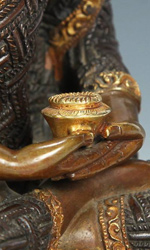 |
||
3) Third on the list is Amitabha Buddha. He is also called Amita or Amida Buddha. The entire ‘Pure Land’ sect of Buddhism revolves around him, believing him to be the guardian of the paradise in the West. The Pure Land sect is a branch of Buddhism practiced primarily in East Asia and one of the largest sects in Buddhism. Consequently, he is shown in the western (left hand) position in mandalas. Amitabha represents pure perception and deep awareness; specifically, of the emptiness of all things. He embodies the third skandha, perception. This skandha encompasses all thinking to determine whether or not any feeling or object is recognized.
Amitabha is always shown with his hands in the meditative mudra called Dhyana, also known as Buddha’s mudra or the mudra of meditation. In this mudra two hands are placed on the lap, palms up with the fingers overlapped, thumbs in close proximity or touching; or fingers alone touching. This mudra is also very commonly used in depictions of Shakyamuni Buddha. What usually distinguishes Amitabha from Shakyamuni is the addition of an alms bowl on top of the Dhyana mudra. Amitabha is famous for longevity and it is said this bowl contains the elixir of life. His name means ‘infinite light’ and he is sometimes referred to as the ‘The Buddha of Immeasurable Life and Light.’ Known for mercy, wisdom, gentleness, and openness; it is believed that reciting his name in mantras will ensure ending the endless cycle of birth and rebirth. Another important attribute of Amitabha is the lotus, which represents gentleness and purity. His color is red, the color associated with compassion and meditative absorption, and he is sometimes depicted in this color.
Tips to identifying Amitabha: the color red, the Dhyana mudra, his placement in a western (left hand) position on a mandala, the appearance of an alms bowl on top of the mudra and/or the appearance of a lotus as attributes.
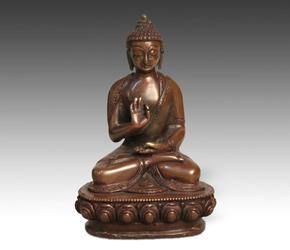 |
|
A0607-432 |
4) In the northern position is Amoghasiddhi, who symbolizes energy and accomplishment. His name literally means infallible success and he embodies the fourth skandha, mental formations, which include all mental states both virtuous and non-virtuous, habits prejudices and predispositions. Arguably, it is these mental states that lead to actions resulting in karma. Amogasiddhi is known for his fearlessness – especially of evils such as envy and bitterness – and this is reflected in his mudra called abhaya. In fact, abhaya in Sanskrit means fearlessness. This mudra symbolizes protection and peace in addition to the dispelling of fear. The mudra is made by holding the right hand out, palm facing outward, fingers upright. It looks like the western gesture to stop; but it is meant to be a pacifying gesture implying fearlessness before any potential enemy; and is known as the ‘fear not’ gesture.
Amogasiddhi governs the path to overcoming fear and transforming negativity into wisdom. His main attribute or symbol is a crossed vajra, also known as a double dorje in Tibetan. The word vajra in Sanskrit means both thunderbolt and diamond, and is used to describe a ritual tool said to have the properties of a diamond (indestructibility) and a thunderbolt (irresistible force). Doubled or crossed, the vajra represents the greatest firmness of spirit capable of cutting through anything. Amogasiddhi is associated with the color green because of its tranquil quality.
Tips to identifying Amogasiddhi: the color green, Abhaya mudra, his placement at the top or northern position in a mandala, and the appearance of a crossed vajra.
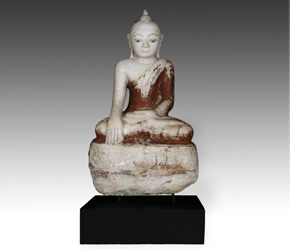 |
|
5) In the east or right hand position on a mandala is Dhyani Buddha Akshobhya, known as the 'Immovable One' because he can never be moved to anger or hatred. Akshobya is associated with the concept of “mirror knowledge,” which simply put, is the knowledge of what is real versus illusion. This Dhyani Buddha represents the overcoming of passions such as anger and hatred toward all sentient beings. He embodies the fifth skandha, consciousness. This skandha can be viewed as awareness devoid of judgment or conceptualization. It has been explained as the pure experience of the other skandhas combined.
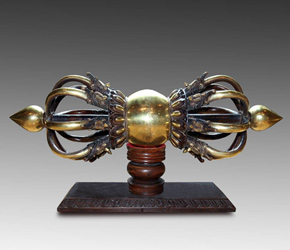 |
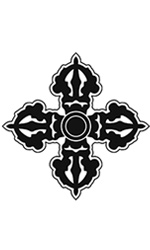 |
||
The mudra of Akshobya is called Bhumisparsa, which is translated as the “earth touching gesture,” also known as the “calling the earth to witness” gesture. In this mudra, the right hand is pendant over the right knee reaching toward the ground with the palm inward. Meanwhile, the left hand is placed palm upward in the lap in the meditative position. The mythology surrounding Akshobya and this mudra states Akshobya used this mudra to transform anger into wisdom. The main attribute of Akshobya is the vajra. The vajra is a ritual tool symbolizing the capacity to break through illusion into the purity of being. Unlike Dhyani Buddha Amogasiddhi’s symbol of a crossed vajra or double dorje, Akshobya’s vajra is single. Whether single or double, the vajra can be said to denote enlightenment, the indestructible nature of pure consciousness, and the essence of reality. The color of Akshobya is blue, the color embodying the transmutation of energy from hatred and aggression into wisdom and enlightenment.
Tips to identifying Akshobya: the color blue, the Bhumisparsa Mudra, his placement in the eastern (right hand) position in a mandala, and the appearance of a vajra in his hands as an attribute.
Here’s a quick summary to help differentiate the Dhyani Buddhas:
| NAME | SKANDHA | POSITION | MUDRA | ATTRIBUTE | COLOR |
|---|---|---|---|---|---|
| Vairocana | 1st, Physical Form | Center | Dharmachakra | Dharma Wheel | White |
| Ratnasambhava | 2nd, Sensation | South, Bottom | Varada | Jewels | Yellow |
| Amitabha | 3rd, Perception | West, Left | Dhyana | Alms Bowl/Lotus | Red |
| Amogasiddhi | 4th, Mental Formations | North, Top | Abhaya | Crossed Vajra | Green |
| Akshobya | 5th, Consciousness | East, Right | Bhumisparsa | Vajra | Blue |